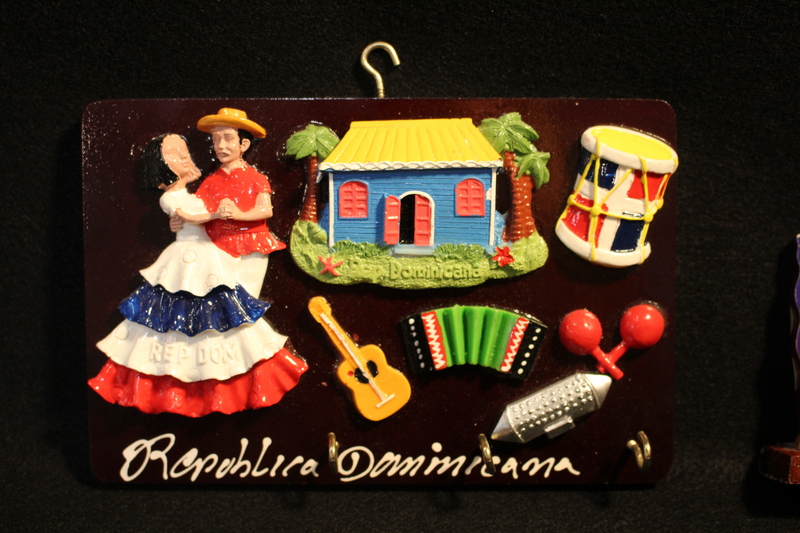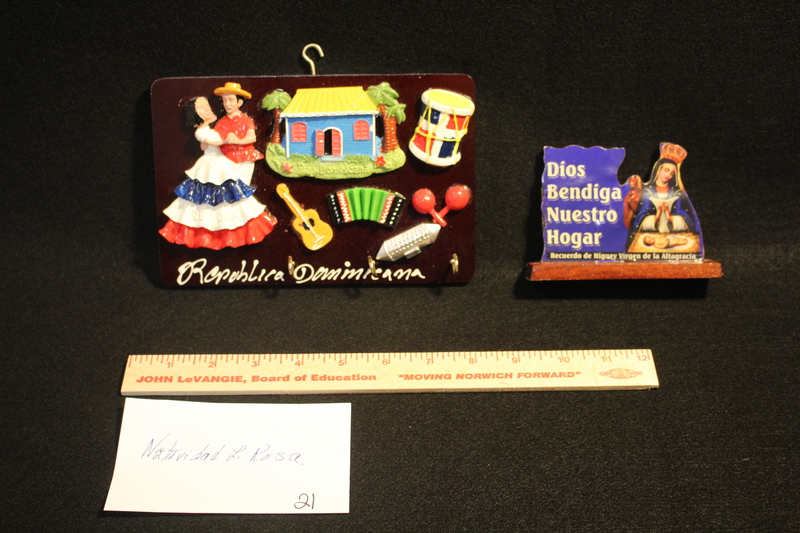Keychain
Title
Subject
Dominican Republic
Souvenirs (Keepsakes)
Description
Natividad Rosa uses her souvenir to hold her keys. She received this keyholder from one of her friends that came back from a trip to Dominican Republic. This keyholder has painted figurines that depicted a guitar, maracas, Guira, accordion, flowers, palm trees, and people dancing while dressed in their traditional wear. Natividad’s friend gave her this gift approximately three years ago. Natividad spoke clearly about how the key holder depicted the passion for merengue and bachata which was, “nuestra musica”. This translates to our music. To begin with some basic history, Bachata is a new genre of music that originated in the Dominican Republic in the 1960’s. The categories it falls under is romantic and dance music.
As described in Pacini (1989) article, Social Identity and Class in “Bachata”, an Emerging Dominican Popular Music, in the Dominican Republic, “the term bachata originally referred to a spontaneous, informal backyard get-together, principally in rural areas, with food and drink, and enlivened by either guitar or accordion -based music” (70). This would explain the accordion, guitar, and outdoor gathering that is depicted on the key holder. However, bachata is no longer consider as an outdoor gathering but instead, a music style that is danced throughout most of the Caribbean who have Spanish descent.
Instruments were a crucial part to Dominican culture and music. Pacini (1989) further describes, “After the accordion was introduced to the Dominican Republic in the 1870s, it became the principal instrument along with the guira (scraper) and tambura (hand drum), of what today is considered merengue tipico” (70). This would explain the guira and hand drum that are depicted on the key holder and what Natividad spoke of so proudly. Bachata and merengue were both used several instruments to achieve that unique sound and Caribbean rhythm. To continue, if an accordion wasn’t available to play bachata or merengue, Dominicans would use a guitar.
There was a change in the instruments used for bachata and merengue, the guira was replaced with the maraca because the sounds were rather similar. But, as Pacini (1989) notes, bachata remained the same, “-the guitar ensemble, simple percussion, lyrics about sentiments, - and its rural associations” (71). The music in the Dominican Republic resembles much of the music in Mexico, Cuba, Colombia, and the most of all, Puerto Rico. Pacini-Hernandez (2014) emphasizes that, “bachatas unique style of guitar playing draws its rhythmic flow from traditional Afro-Dominican salves, songs dedicated to the Virgin Mary (Woolfe 2004), although other Afro-Caribbean influences can be heard in sub-styles of bachata” (1029). This is important because Bachata and Merengue was created and influenced by African and Spaniard styles of music.
Dominican culture, again, resembles Puerto Rican culture greatly. This would explain why Dominican Republicans migrate to Puerto Rico as Funkhouser and Ramos (1993) explain, “Puerto Rico provides an alternative destination for immigrants from the Spanish-speaking Caribbean because the culture is similar to that in the source country” (537). They are ten times more likely to move to Puerto Rico because of how similar the culture, music, language, and the way of life is.
Citations for Supplementary Sources and Context:
Funkhouser, E., & Ramos, F. A. (1993). The Choice of Migration Destination: Dominican and Cuban Immigrants to the Mainland United States and Puerto Rico. International Migration Review, 27(3), 537. doi:10.2307/2547099
Hernandez, D. P. (n.d.). Social Identity and Class in "Bachata", an Emerging Dominican Popular Music.
Hernandez, D. P. (2014). Urban Bachata and Dominican Racial Identity in New York. Cahiers Détudes Africaines, (216), 1027-1054. doi:10.4000/etudesafricaines.17927.

